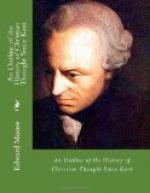The miracles which are related in the Scripture may be divided for our consideration into three classes. To the first class belong most of those which are related in the Old Testament, but some also which are conspicuous in the New Testament. They are, in some cases, the poetical and imaginative representation of the profoundest religious ideas. So soon as one openly concedes this, when there is no longer any necessity either to attack or to defend the miracle in question, one is in a position to acknowledge how deep and wonderful the thoughts often are and how beautiful the form in which they are conveyed. It is through imagination and symbolism that we are able to convey the subtlest meanings which we have. Still more was this the case with men of an earlier age. In the second place, the narratives of miracles are, some of them, of such a sort that we may say that an event or circumstance in nature has been obviously apprehended in naive fashion. This by no means forbids us to interpret that same event in quite a different way. The men of former time, exactly in proportion as they had less sense of the order of nature than have we, so were they also far readier to assume the immediate forthputting of the power of God. This was true not merely of the uneducated. It is difficult, or even impossible, for us to find out what the event was. Fact and apprehension are inextricably interwoven. That which really happened is concealed from us by the tale which had intended to reveal it. In the third place, there are many cases in the history of Jesus, and some in that of the apostles and prophets, in which that which is related moves in the borderland between body and soul, spirit and matter, the region of the influence of will, one’s own or that of another, over physical conditions. Concerning such cases we are disposed, far more than were men even a few years ago, to concede that there is much that is by no means yet investigated, and the soundest judgment we can form is far from being sure. Even if we recognise to the full the lamentable resurgence of outworn superstitions and stupidities, which again pass current among us for an unhappy moment, if we detect the questionable or manifestly evil consequences of certain uses made or alleged of psychic influence, yet still we are not always in a position to say, with certainty, what is true in tales of healing which we hear in our own day. There are certain of the statements concerning Jesus’ healing power and action which are absolutely baffling. They can be eliminated from the narrative only by a procedure which might just as well eliminate the narrative. In many of the narratives there may be much that is true. In some all may be as related. In Jesus’ time, on the witness of the Scripture itself, it was assumed as something no one questioned, that miraculous deeds were performed, not alone by Jesus and the apostles, but by many others, and not always even by the good. Such deeds were




